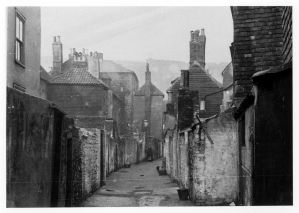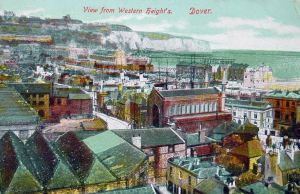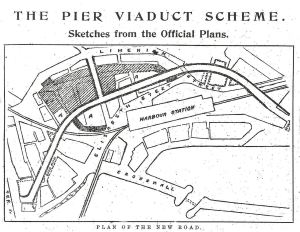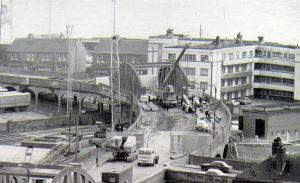In the nineteenth and early twentieth centuries the Pier District – the area around Dover’s Western Docks – was aptly described by Pierite and former headmistress of Dover Girls’ Grammar School, Lillian Kay (1914-2013), as ‘a rabbit warren of houses, alleyways and rows or pubs.’
Originating in the 15th century, the Pier District evolved on reclaimed land. Towards the end of the 19th century the Dover Harbour Board (DHB) along with Dover Corporation and the two railway companies that served Dover, decided make the harbour, then on the Western side of the bay, more accessible. The two railway companies were the South Eastern Railway Company, which operated the line through Shakespeare Tunnel to the then Town Station in the Pier District, and the London, Chatham and Dover Railway Company, the owner of Harbour Station also in the Pier District.
In 1891, an Act of Parliament was obtained for the construction of the Dover Commercial Harbour then, in 1895, this was upgraded to the Admiralty Harbour. It was quickly recognised that on completion the new harbour would turn Dover into a major port. On 1 January 1899, the two railway companies joined forces and operated under a single Management Committee. In the meantime they were in discussion with both the council – which was under the leadership of thirteen times Mayor, Sir William Crundall and DHB, which Crundall was a member becoming, Chairman in 1906 to 1934.
It was agreed by all to demolish part of the Pier District in order to create railway sidings, loco sheds and an approach road from the town. To help the justify demolishing such a populous area, the council set up the Pier Dwellings Committee. The Committee justified the demolition by saying that the area was slums and recommended paying £37,000 to purchase of the houses from the Harbour Board. Further, as the proposed new road would cross a series of railway tracks the council, in October 1900, decided to build a viaduct. The cost of this was estimated at £106,000 but the railway companies did agree to pay part.
The council submitted a Bill to Parliament that included a Spur from the proposed Viaduct to Archcliffe Road and the widening of Limekiln Street, Bulwark Street and Beach Street. This, they estimated, would mean the demolition of 400 homes. The result was the Dover Corporation Act of 1901 and the general populace of Dover were sold the idea through the local press. The media extolled the virtues of the project by labelling it the ‘Pier improvement scheme.’ Although the potentially displaced Pierites made their anger felt, the council, local press and general populace felt that there was plenty of cheap accommodation in Dover and they could move.
However, what was a cause of concern was the cost of the scheme to local ratepayers. To 30 November 1903, it had cost some £6,000 and that was just the beginning – the Viaduct itself was yet to be built. It was this that put the scheme on back burner and the powers of the Act ran out of time. Two years later the Corporation promoted another Bill through Parliament for the extension of the time for the erection of the Viaduct. Included in the Bill was a scheme to improve the drainage on Maison Dieu Road and Folkestone Road.
The Admiral of the Fleet, George, the Prince of Wales, opened the new Admiralty Harbour on 15 October 1909. This galvanised the council and railway companies into pursing what was, by then, called the Viaduct Scheme. By this time it was recognised that housing for the potentially displaced Pierites may be a problem, so it was agreed to build 24 ‘workmen’s dwellings’ on Beach Street, close to the Town Station.
Application was again made to Parliament, but the token number of new dwellings was not acceptable to the Local Government Board (a Government Ministry). Nonetheless, as dwellings became vacant roofs were removed. To add weight to this, the Dover Medical Officer of Health produced a report showing that all the proposed houses for demolition were unfit for occupation.
The Pierites made their displeasure felt, in 1911, through the ballot box. They chose Independent Richard Barwick, founder of the building firm that had been involved in the Admiralty Pier construction, to pursue their demand for homes. At a public meeting on 16 January 1912, the Viaduct plans were rejected by the large majority of the townsfolk.
The council responded by balloting all ratepayers and won 2,387 to 1,706 but only half of those eligible voted. Nonetheless, the Corporation successfully promoted the new Act through Parliament, which enabled them to demolish a large swathe of the Pier District. The Act included the Viaduct proposal – a route to the Town and Harbour stations that were free of railway crossings. The total cost was estimated at £82,087, of which £40,000 was to be borne by the railway companies. They, as part of the deal, would gain a large stretch of land for sidings following the demolition of 311 homes and for each and every household in Dover 1½d would be added to the rates.
However, as the Bill was going through the due process, the Local Government Board included a condition that all Pier people displaced over the previous 15 years should be re-housed. Consequently, the original intention was modified and it was agreed that the council would build 90 houses to replace 311 to be demolished. Other problems included access to Harbour Station and Archcliffe Fort but modifications to the design dealt with both.
On 15 April 1913 the council accepted tenders for the construction of the Viaduct, they included, Messrs Lambrick and Co. £14,480, for the ferro-concrete construction and Messrs Dick, Kerr and Co. £2,892 for a tramway along on the Viaduct. The latter tender was later transferred to Messrs Paramours Ltd and the tender of Messrs Landbrick and Co. was increased by £1,000 on 22 July 1913. Demolition of homes and the Cinque Port Pilots’ Tower was started immediately. The following day the Local Government Board held an Inquiry on the housing conditions of the Pier District and evidence was openly hostile to the demolition proposals.
The Local Government Board did not give the support that was hoped for ans on 29 April the whole question was decided on a resolution by Alderman Baker, who moved that the tenders were not to be accepted. The vote resulted in a tie 11-11, the Mayor William Bromley gave his casting vote in favour of carrying out the scheme. That year saw Edwin Farley, another Independent, elected Mayor. Nonetheless, work was in hand, the ferro-concrete spread bases for the Viaduct were laid and the approach to Admiralty Pier was finished. On 3 July 1914 the South Eastern and Chatham Railway Companies paid £40,000 towards the scheme but on on 4 August World War I broke out and all further work was stopped.
The Borough of Dover, under the Defence of the Realm Act, was part of Dover Fortress, which meant that the military were in charge. Although local or parliamentary elections were suspended by a ruling of the Privy Council, councillors continued in office. Mayor Farley was re-elected in November 1914, 15, 16, 17 and 1918 and some works did take place. In 1917 the Council were unable to carry out any new works and in the autumn were prohibited from further proceeding during the War with the Pier Viaduct works. These had already been greatly delayed by the effects of the War; and the contractors for the ferro-concrete, who completed that portion of the work in May, claimed £11,000 as a result of the delay, and finally accepted, on 17 October, a sum of £5,000 in settlement.
Following the War, the Viaduct scheme was given priority and in the Pier District 400 houses and 30 pubs were demolished. Designed by L G Mouchel and Partners of Westminster the Viaduct, made of reinforced concrete, was 1,000-foot long (305 metres), the approaches 45-foot (approx.13.7 metres) wide between parapets with a 30-foot (9metres) carriageway sided by 7-foot 6- inch (2.3 metres) footways with two stairways leading up to it. It was supported on pillars on the spread bases and made up of two bowstring girder bridges with span of 67 and 70-feet (approx. 19 metres). The main booms had an overall length of 74-feet (22.5 metres) and 77-feet (23.5 metres) respectively.
Originally, the road was to be surfaced with wooden blocks but in the event, asphalt slag on cushion concrete was used. The plan included an overhead conductor wire so trams could terminate at the Lord Warden Hotel but this was abandoned as a waste of public money. The testing of the crossbeams was carried out with sandbags weighing 41 tons and men standing on them.

Opening the associated Strond Street footbridge 1925, left Mayor Barwick next to, probably, William E Boulton Smith, the Town Surveyor and responsible for all the works. Richard Barwick
On 9 January 1922, the Mayoress, Mrs Richard Barwick, opened the Viaduct to traffic by which time the population of the Pier district had fallen from 4,000 to 2,000. The Ministry of Health had replaced the Local Government Board and with their subsidies augmented by council finance, some of the displaced Pierites moved into newly built houses on the Ropeway Meadow, Aycliffe. This was on former military land and the Corporation using local contractors, that included Barwicks, to build the new homes.
The Viaduct was hailed as a success as it provided the access for which it was designed. However, the narrowness of Snargate Street caused traffic jams that were eventually rectified following an Act of Parliament in 1928. That Act authorised DHB to demolish all properties on the seaward side of the Street, below its junction with the then Northampton Street.
The residents of those properties, together with the remaining former residents of the Pier District who been displaced, had to wait to be re-housed until after 21 April 1930. On that date, the Coalition Government introduced the Housing Act that provided subsidies to rid the country of slums. The country was in a deep depression and the Act was aimed at getting the economy moving again.

St Martins House, Hawkesbury Street – all that remains of the pre-war redevelopment of the Pier District
Under the scheme, the Pier District was rejuvenated with blocks of aesthetically pleasing flats built on Limekiln Street, near the Viaduct in 1935 – one still remains. These were followed, in 1936-7, by utilitarian flats in Seven Star Street and on the site of what had been the Sailors’ Home but had been replaced by the Dover Patrol Hostel on Wellesley Road opened in 1923.
In April 1972, large cracks were reported and the Viaduct was declared unsafe and closed to traffic. Demolition was started the following February and a temporary viaduct erected. Start on the permanent Viaduct did not begin until 1976 and cost over £1m. It was again modified, in the 1990s to bring it in line with the new A20.
- Published:
- Dover Mercury: 10 & 17 March 2011









